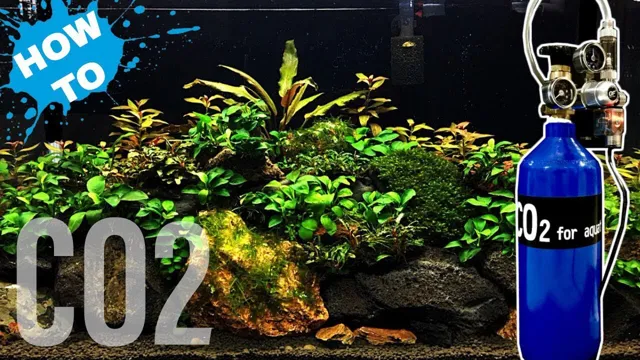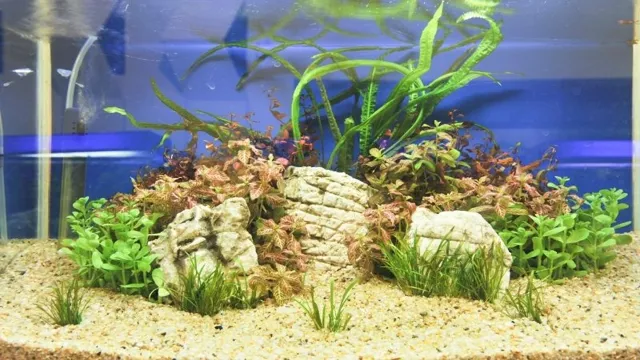How to Fine Tune CO2 Aquarium and Achieve Optimal Water Quality

Are you struggling to maintain a healthy CO2 balance in your aquarium? Do you find that your plants are not growing as they should? One of the most common issues aquarium owners face is fine-tuning CO2 levels to ensure both fish and plants thrive. CO2 is essential for photosynthesis and is vital for plant growth. Yet, too much CO2 can be harmful to the fishes.
Finding the right balance can be tricky, but with a few simple tweaks, you can create the perfect CO2 environment for your aquarium. Think of your aquarium as a mini-ecosystem; everything is interconnected and requires balance to thrive. Just like how nature thrives on balance, your aquarium needs the correct environment for your plants and fishes to flourish.
Plants will consume and remove CO2, producing oxygen while also absorbing other nutrients and minerals, which is ideal for fishes to thrive. However, when the plants are too numerous or grow too fast, the CO2 supply can get depleted, which can be harmful to fishes. That’s why it’s essential to fine-tune the amount of CO2 in your tank to maintain a healthy balance.
You can do this by controlling factors like the amount of light exposure, selecting the right plants, implementing a CO2 regulator, and testing water parameters regularly. By doing this, your CO2 levels will be stable, and the aquarium plants and fishes will thrive. With a little effort and patience, you can create a balanced environment for your fishes, cultivating a beautiful space you can enjoy for years.
Understanding CO2 in Aquariums
If you’re a freshwater aquarium enthusiast, then you already know how vital CO2 is for aquatic plants’ growth. Carbon dioxide deficiency can lead to poor plant health, algae overgrowth, and even fish death. That’s why fine-tuning CO2 levels in your aquarium is a crucial aspect of maintaining a healthy tank.
First and foremost, you’ll need a CO2 monitor to check CO2 concentrations regularly. Once you know what your CO2 levels are, you can adjust them using a CO2 regulator. This setup will allow you to adjust the CO2 output and distribute it evenly throughout the tank.
Keep in mind that the amount of CO2 your plants need will depend on several factors, including the number of plants, the number of fish, and the intensity of your lighting. By paying attention to these factors and fine-tuning your CO2 levels accordingly, you’ll be able to create a thriving aquarium that showcases lush and healthy aquatic plants.
Factors Affecting CO2 Levels
CO2 levels in aquariums can be affected by a range of factors such as the type of plants and animals present, water flow, and the level of lighting. Plant growth and the amount of CO2 dissolved in water are interrelated, as plants require carbon dioxide for photosynthesis. When aquarium plants are abundant, they use up CO2, requiring an addition of CO2 to maintain a balanced level.
A steady water flow helps with the even distribution of carbon dioxide, ensuring plants receive their required amount. Another important factor is the level of lighting, as the brighter the light, the more photosynthesis occurs, which leads to the greater consumption of CO Managing CO2 levels in aquariums is crucial for the health and growth of aquatic species, as well as the overall balance of the ecosystem.
It is essential to regularly monitor CO2 levels through testing to ensure a healthy and thriving aquatic environment.

The Importance of CO2 in Aquatic Plant Growth
Aquariums CO2 plays a crucial role in promoting the growth and development of aquatic plants in aquariums. Understanding its importance is essential for any aquarist. The level of CO2 in a planted aquarium is directly linked to the growth rate of aquatic plants.
A sufficient level of CO2 facilitates photosynthesis, which is the process by which plants convert light energy into food. As a result, a drop in CO2 levels can result in slower growth rates or even death of aquatic plants. Aquarists can maintain optimal CO2 levels by injecting it into the aquarium through various means, including diffusers, reactors, or tablets.
Overall, monitoring and regulating CO2 levels in an aquarium is a critical aspect of aquatic plant development and should be given careful attention.
Monitoring CO2 Levels
If you want to create a thriving aquarium, you need to pay close attention to the CO2 levels. Too little CO2 and your plants won’t grow as well, but too much CO2 can harm the fish. To fine-tune your CO2 levels, the first step is to invest in a high-quality CO2 monitor.
This device allows you to track your CO2 levels in real-time, so you can adjust them as necessary. You may also need to adjust your lighting and nutrients to maintain balance. It’s important to remember that CO2 levels can fluctuate throughout the day, so it’s a good idea to check your monitor at different times and adjust accordingly.
With time, practice, and patience, you’ll be able to establish the perfect balance of CO2 for your aquarium, and your plants and fish will thrive. Just remember to keep an eye on your CO2 levels to ensure that they remain within a healthy range.
Testing Methods and Tools
As we become more aware of the impact we have on the environment, monitoring CO2 levels has become increasingly important. There are several methods and tools available for measuring CO2 levels, each with its own advantages and disadvantages. One of the most common methods used is infrared gas analyzers.
This tool works by detecting the amount of infrared radiation absorbed by CO2 molecules, which provides a precise measurement of CO2 levels. Another tool that is often used for monitoring CO2 levels is a data logger. This tool records data over a period of time, which can then be analyzed to determine average CO2 levels over the designated time frame.
Both of these tools have proven to be effective in monitoring CO2 levels, and can be incredibly useful for identifying potential environmental concerns in any given area. By using these tools, we can work towards creating a better, more sustainable future for ourselves and the planet.
Ideal CO2 Levels for Planted Aquariums
When it comes to maintaining a healthy planted aquarium, monitoring the CO2 levels is crucial. The ideal CO2 levels for a planted aquarium range between 20-30 ppm (parts per million). Maintaining a consistent CO2 level is essential for plant growth, as too much or too little can have adverse effects.
If CO2 levels are too high, it can lead to an imbalance in the water and cause harm to fish and other aquatic life. On the other hand, too little CO2 can result in stunted plant growth and leave your aquarium looking lackluster. The best way to monitor CO2 levels is by using a CO2 drop checker, which changes color based on the CO2 concentration in the water.
Keeping an eye on CO2 levels and making adjustments when necessary will ensure that your aquarium remains a thriving environment for your aquatic pets and plants.
Adjusting CO2 Levels
When setting up an aquarium, it’s crucial to balance the CO2 levels for your plants and fish to thrive. Fine-tuning CO2 levels in the aquarium can be tricky but not impossible. The first step is to understand the requirements of your plants and the kind of fish you have.
Once you’ve established this, you need to take note of the pH levels and adjust accordingly. A pH level of between 5-
5 is ideal for most aquatic life forms. A CO2 regulator and diffuser system can also be used as it provides a controlled release of CO Ensure that the diffusion rate is consistent and doesn’t exceed the level required for your plants and fish.
Monitoring CO2 levels is an essential part of maintaining a healthy aquatic environment. Consistent monitoring with a CO2 test kit should be done, and adjustments should be made based on the test results. With careful monitoring, it’s possible to have a thriving aquarium with the perfect CO2 level for your plants and fish to flourish.
CO2 Injection Techniques
CO2 injection is a method utilized to enhance the growth and yield of crops by enriching the aerial environment around them with additional carbon dioxide. This technique works wonders, especially in greenhouse cultivation, where the CO2 level is typically much lower than what plants prefer to grow at their optimal rate. The injection of CO2 can be conducted in different ways, such as passively using charcoal or calcium carbonate, actively through pressurized tanks, or using sophisticated automated systems with sensors to maintain ideal CO2 levels around plants.
However, regardless of the injection method, it is essential to regularly monitor the CO2 levels to ensure that they do not exceed harmful limits that may damage plant growth and health. By using CO2 injection, farmers and horticulturists can regulate the environment around their plants and obtain maximum yields, thereby contributing to the food supply and the environment.
Regulating CO2 Using a Drop Checker
Regulating CO2 using a drop checker is a simple and effective way to ensure that the levels of carbon dioxide in your aquarium are at the optimal range for your fish and plants to thrive. A drop checker consists of a small glass or plastic container filled with a solution that changes color when exposed to carbon dioxide. By attaching the drop checker to your aquarium and monitoring the color of the solution, you can easily adjust the CO2 levels by increasing or decreasing the amount of CO2 injected into the tank.
This method is especially useful for those who are new to aquatic plant keeping, as it provides a visual cue that helps to gauge whether the CO2 levels are too high or too low. With a drop checker, you can be confident that your aquarium is well-regulated, and your plants and fish are happy and healthy.
Maintaining CO2 Levels
Maintaining the proper CO2 levels in your aquarium is crucial for the health of your aquatic plants and fish. There are several different methods to fine-tune the CO2 levels in your aquarium, depending on the size of your tank and the types of plants and fish you have. One popular method is using a CO2 injector, which can be adjusted to release the exact amount of CO2 your plants need.
Another method is utilizing a pH controller, which automatically regulates the amount of CO2 in your tank based on the pH level. It’s important to monitor the CO2 levels regularly and make adjustments as needed to prevent fluctuations that can harm your aquarium inhabitants. Keep in mind that other factors like water flow, lighting, and nutrient levels can also affect CO2 absorption, so it’s important to maintain a balance of all these elements.
With the proper care and attention, you can maintain healthy CO2 levels in your aquarium and enjoy a thriving aquatic ecosystem.
Avoiding CO2 Fluctuations
Maintaining consistent CO2 levels is vital for numerous reasons, from plant growth to human health. Fluctuating levels of CO2 can occur for various reasons, including changes in temperature, human activity, and seasonal variation. One effective way to avoid CO2 fluctuations is by improving ventilation.
Poorly ventilated areas can result in a build-up of CO2, which can cause headaches, dizziness, and irritability in humans. In addition, plants located in poorly ventilated areas may experience inhibited growth due to the lack of CO Ensuring proper ventilation and reducing human activity in enclosed areas are simple ways to maintain consistent CO2 levels.
Monitoring CO2 levels regularly can also help identify any fluctuations that may occur, allowing for prompt action to be taken. Overall, maintaining consistent CO2 levels is critical for creating a healthy and stable environment for all living organisms.
Routine CO2 System Maintenance
Maintaining CO2 levels in an aquarium is essential for the health and well-being of aquatic plants and animals. Routine CO2 system maintenance ensures that CO2 levels don’t fall below or rise above the optimal range. One of the easiest ways to maintain CO2 levels is by performing regular water changes.
This not only helps remove excess CO2 but also replenishes vital nutrients that help keep plants healthy. A drop checker is another helpful tool that helps monitor CO2 levels. It’s also crucial to clean and replace CO2 diffusers and check valves regularly because they can become clogged, leading to lower CO2 levels.
Lastly, ensure that CO2 tanks are kept in a cool, dry, and well-ventilated area, away from sunlight and heat sources. With proper routine maintenance, maintaining optimal CO2 levels in your aquarium will be a breeze.
Conclusion
In the world of aquariums, fine tuning CO2 levels is a delicate dance between science and art. To get your water chemistry just right, you need to be patient, observant, and willing to experiment. Think of your aquarium like a symphony, with CO2 acting as the conductor.
By making small adjustments and paying close attention to the needs of your aquatic friends, you can create an environment that’s both beautiful and harmonious. So grab your lab coat, dust off your chemistry skills, and get ready to create a masterpiece!”
FAQs
What is the purpose of fine-tuning CO2 levels in an aquarium?
Fine-tuning CO2 levels in an aquarium is important for promoting healthy plant growth and ensuring a balanced ecosystem.
How do I know if I need to fine-tune my CO2 levels?
You can observe your plants for signs of CO2 deficiency, such as slow growth, yellowing leaves, and stunted development.
What are the different methods for adding CO2 to an aquarium?
There are several methods for adding CO2 to an aquarium, including via a diffuser, reactor, or inline atomizer.
How often should I test my CO2 levels?
It is recommended to test CO2 levels at least once a week to ensure they are within a healthy range.
What is the ideal CO2 level for a planted aquarium?
The ideal CO2 level for a planted aquarium ranges from 20-30 parts per million (ppm).
Can too much CO2 harm my fish?
Yes, too much CO2 can harm fish by causing respiratory distress and even death in extreme cases.
How do I adjust my CO2 levels if they are too high or too low?
To adjust CO2 levels, you can increase or decrease the amount of CO2 added to the aquarium or adjust the rate of water flow through the CO2 diffuser.






